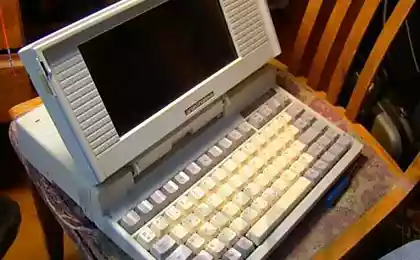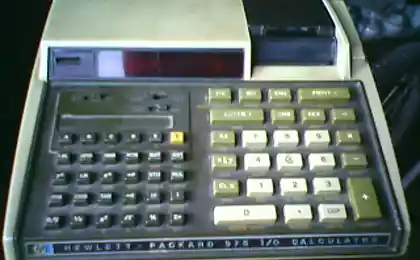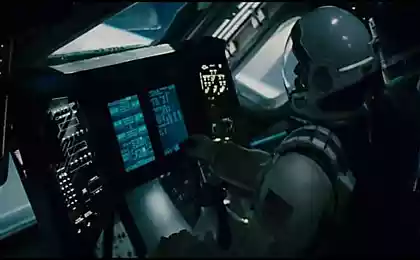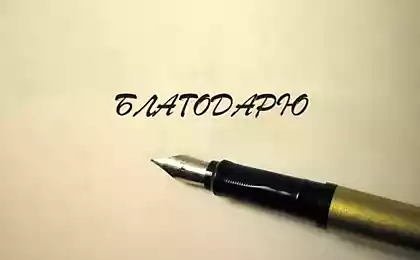570
6 technologies for which the world must thank 1960
1960 - a period of great events and changes in the lives of the world's population. Cuban Missile Crisis, the first manned space flight, the first landing on the moon. And if the associated dates fit into the historical records as the most important almost immediately, other accomplishments, exercise in full of laboratory equipment, received well-deserved honors not immediately. No wonder: a kind of new development should have the potential to be the time to consider, to understand the nature of the applied use of and be able to establish a large-scale release. In other words, consistently, over the years to solve a complex of tasks, often beyond the control of a single inventor or media ideas. But being incarnate in real devices and equipment, these innovative technologies have changed the world at least, and maybe even more than most known historical landmarks.
1. The first video game console

Definitely assign the title to the first set-top box or other device is difficult, because in fact it is possible to name any prototype calculating machine, an entertaining function of the presence of the image and / or sound. But as close as possible to today's Wii and Xbox with a maximum historical remoteness development came Ralph Baer (Ralph Baer), began to create its own system in 1966. In May 1967, he realized the opportunity to play together, and a year later completed the establishment of a working prototype. Went on sale in 1972, the set-top box called Magnavox Odyssey (among users was called the Brown Box).

Among its hardware was not a microprocessor, all operations are performed several tens of transistors and other elements. Games - volleyball, soccer, ping-pong - were "recorded" in the cartridge such maps, which served as additions to the electronic circuit console, only connecting one or another of its parts through electrical contacts. As a result of changing images on the screen. Controller served is not an ergonomic device with two rotating regulators. One object is moved on the screen along the horizontal axis, and the other - the vertical. Furthermore, it was possible to acquire visible-light weapon. By 1975, sales amounted to 350 thousand Odyssey. Units, then came Odyssey 100.
2. The first computer mouse
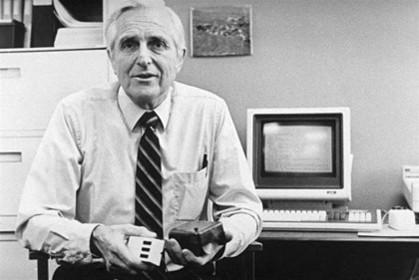
Fundamentally change the approach to the human-computer interaction Douglas Engelbart (Douglas Engelbart). Significant event happened in 1964, when for the first time there was a device with a wooden body and two perpendicular to one another swivel casters. Accordingly, the manipulator can move only along one axis.

The patent for the invention was obtained in 1967. Document title read: «XY position indicator for a display system» («XY Position Indicator for a Display System»). As Engelbart himself admitted, he had no idea why, among other options got the name "mouse" - is, in his words, just "stuck" to the device when it was first uttered.
3. Light emitting diodes
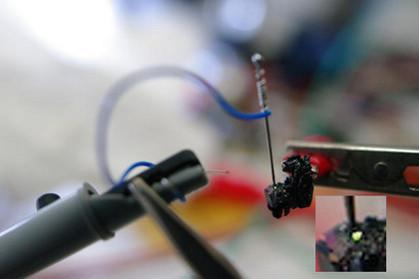
The first work on light-emitting diodes are dated 1907 and are associated with the name of Marconi's assistant, Henry Joseph Round (Henry Joseph Round). LED is also considered the inventor of the Soviet physicist Oleg Losev, but the first working prototype for the visible spectral range was manufactured in 1962. Collaborated with General Electric Golonyak Nick (Nick Holonyak) created with faint red LED light. Then, thanks to the work of the former student Golonyaka Kreforda George (George Craford) appeared yellow and red with increased brightness LEDs in 1972. The image - a reconstruction of the experiment round, when was discovered the principle of operation of the LED. Emission occurs by passing current through a pn junction, and the color depends on the semiconductor materials.
4. DRAM

Technically Robert Dennard (Robert Dennard) did not invent the data storage device, but he first modified the random access memory, and a prototype was widely used today, DRAM (Dynamic Random Access Memory - volatile random access memory). Engineer set a goal to achieve greater efficiency of RAM to a smaller space, as tended to reduce the cost and size of computers while increasing capabilities. In 1966, Dennard developed the DRAM on a single transistor. The revolutionary idea is to store binary data in the form of positive or negative charges in the capacitors. In 1968 he received a patent for the invention of the two designs memory devices shown in the image.
5. Laser
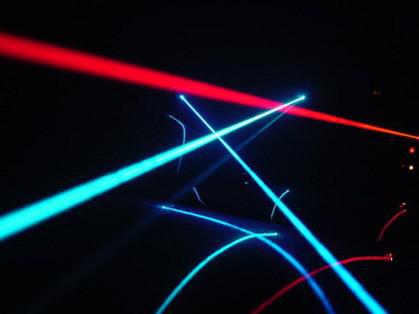
The history of this invention is full of significant steps, without which the computer industry, medicine, science and industry would never see the laser (LASER - Light Amplification by Stimulated Emission of Radiation - light amplification by stimulated emission) and would have been entirely different. The fundamental phenomenon of stimulated emission described theoretically still in the works of Paul Dirac in the late 1920s, when there were the first practical confirmation of the theory. In 1964, the Nobel Prize in Physics for his contributions to quantum electronics, which made it possible to create laser Soviet scientists received Nikolay Basov and Alexander Prokhorov. However, the first working optical maser in 1960 showed Theodore Maiman (Theodore Maiman). This was based on the pulse ruby laser with a wavelength of 694 nm. In the 1960's there were also lasers, where the active medium used organic pigments and carbon dioxide. Developments in the field of improvement of the devices last for today.
6. UNIX
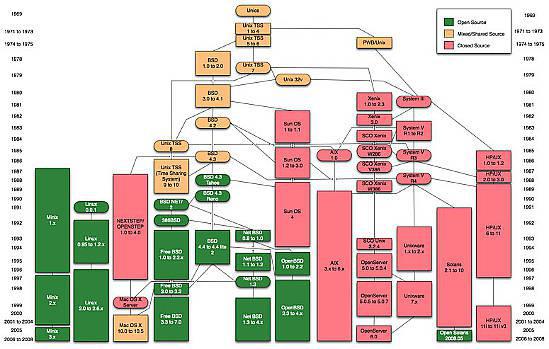
In 1969, a group of employees of AT & T's Bell Labs has created one of which became the foundation of the computer industry operating systems - UNIX. Ken Thompson (Ken Thompson), Dennis Ritchie (Dennis Ritchie), Brian Kerningen (Brian Kernighan), Douglas McIlroy (Douglas Mcllroy) and Joe Ossana (Joe Ossana) - the names of those who launched the first UNIX code on the PDP-7. This marked the beginning of the operating system to a group of multi-tasking multi-user systems, united by the term «UNIX-like", which include and Linux. Originally, the name was one character longer - UNICS (UNIplexed Information and Computing System). Today, based on the principles laid down under UNIX operating systems, including BSD, OpenSolaris, FreeBSD, Mac OS, are used in personal computers, and in the professional computing solutions - servers, mainframes, embedded systems.
1. The first video game console

Definitely assign the title to the first set-top box or other device is difficult, because in fact it is possible to name any prototype calculating machine, an entertaining function of the presence of the image and / or sound. But as close as possible to today's Wii and Xbox with a maximum historical remoteness development came Ralph Baer (Ralph Baer), began to create its own system in 1966. In May 1967, he realized the opportunity to play together, and a year later completed the establishment of a working prototype. Went on sale in 1972, the set-top box called Magnavox Odyssey (among users was called the Brown Box).

Among its hardware was not a microprocessor, all operations are performed several tens of transistors and other elements. Games - volleyball, soccer, ping-pong - were "recorded" in the cartridge such maps, which served as additions to the electronic circuit console, only connecting one or another of its parts through electrical contacts. As a result of changing images on the screen. Controller served is not an ergonomic device with two rotating regulators. One object is moved on the screen along the horizontal axis, and the other - the vertical. Furthermore, it was possible to acquire visible-light weapon. By 1975, sales amounted to 350 thousand Odyssey. Units, then came Odyssey 100.
2. The first computer mouse

Fundamentally change the approach to the human-computer interaction Douglas Engelbart (Douglas Engelbart). Significant event happened in 1964, when for the first time there was a device with a wooden body and two perpendicular to one another swivel casters. Accordingly, the manipulator can move only along one axis.

The patent for the invention was obtained in 1967. Document title read: «XY position indicator for a display system» («XY Position Indicator for a Display System»). As Engelbart himself admitted, he had no idea why, among other options got the name "mouse" - is, in his words, just "stuck" to the device when it was first uttered.
3. Light emitting diodes

The first work on light-emitting diodes are dated 1907 and are associated with the name of Marconi's assistant, Henry Joseph Round (Henry Joseph Round). LED is also considered the inventor of the Soviet physicist Oleg Losev, but the first working prototype for the visible spectral range was manufactured in 1962. Collaborated with General Electric Golonyak Nick (Nick Holonyak) created with faint red LED light. Then, thanks to the work of the former student Golonyaka Kreforda George (George Craford) appeared yellow and red with increased brightness LEDs in 1972. The image - a reconstruction of the experiment round, when was discovered the principle of operation of the LED. Emission occurs by passing current through a pn junction, and the color depends on the semiconductor materials.
4. DRAM

Technically Robert Dennard (Robert Dennard) did not invent the data storage device, but he first modified the random access memory, and a prototype was widely used today, DRAM (Dynamic Random Access Memory - volatile random access memory). Engineer set a goal to achieve greater efficiency of RAM to a smaller space, as tended to reduce the cost and size of computers while increasing capabilities. In 1966, Dennard developed the DRAM on a single transistor. The revolutionary idea is to store binary data in the form of positive or negative charges in the capacitors. In 1968 he received a patent for the invention of the two designs memory devices shown in the image.
5. Laser

The history of this invention is full of significant steps, without which the computer industry, medicine, science and industry would never see the laser (LASER - Light Amplification by Stimulated Emission of Radiation - light amplification by stimulated emission) and would have been entirely different. The fundamental phenomenon of stimulated emission described theoretically still in the works of Paul Dirac in the late 1920s, when there were the first practical confirmation of the theory. In 1964, the Nobel Prize in Physics for his contributions to quantum electronics, which made it possible to create laser Soviet scientists received Nikolay Basov and Alexander Prokhorov. However, the first working optical maser in 1960 showed Theodore Maiman (Theodore Maiman). This was based on the pulse ruby laser with a wavelength of 694 nm. In the 1960's there were also lasers, where the active medium used organic pigments and carbon dioxide. Developments in the field of improvement of the devices last for today.
6. UNIX

In 1969, a group of employees of AT & T's Bell Labs has created one of which became the foundation of the computer industry operating systems - UNIX. Ken Thompson (Ken Thompson), Dennis Ritchie (Dennis Ritchie), Brian Kerningen (Brian Kernighan), Douglas McIlroy (Douglas Mcllroy) and Joe Ossana (Joe Ossana) - the names of those who launched the first UNIX code on the PDP-7. This marked the beginning of the operating system to a group of multi-tasking multi-user systems, united by the term «UNIX-like", which include and Linux. Originally, the name was one character longer - UNICS (UNIplexed Information and Computing System). Today, based on the principles laid down under UNIX operating systems, including BSD, OpenSolaris, FreeBSD, Mac OS, are used in personal computers, and in the professional computing solutions - servers, mainframes, embedded systems.






